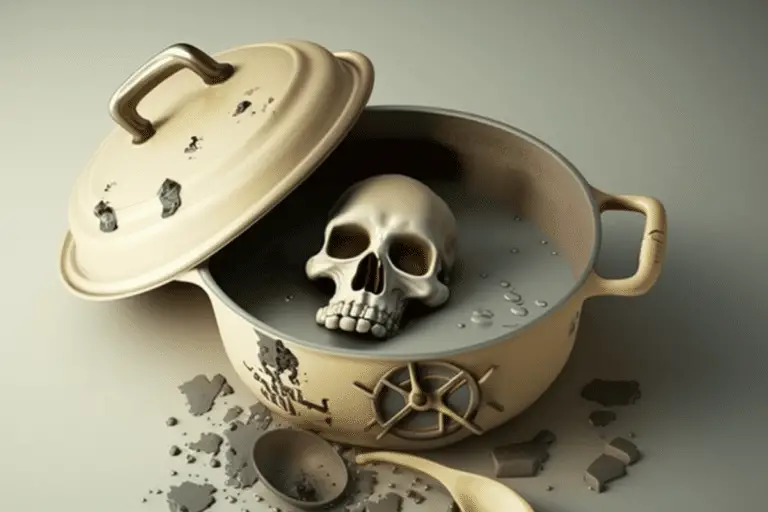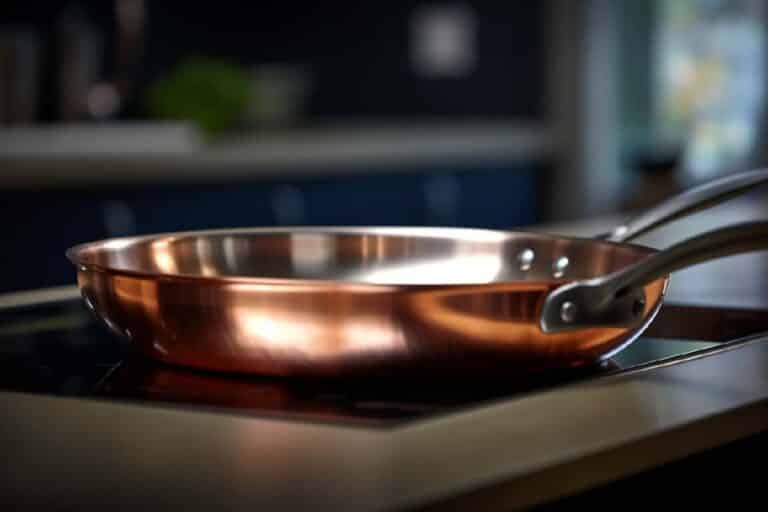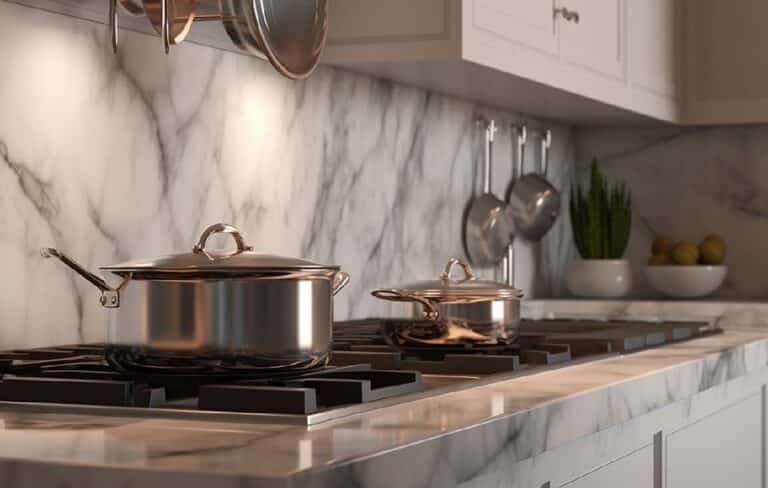Is Calphalon Safe? Revealing the Safe and Unsafe Picks

You’ve got your eyes set on Calphalon, but you want to know how safe it is before you go ahead and buy yourself that shiny new cookware set.
This guide will cover the safety of the materials used by Calphalon ensuring whichever cookware set you have, we cover it.
The following materials are used by Calphalon and will be covered
- Nonstick
- Ceramic
- Stainless Steel
- Cast Iron
But for those in a rush, here’s a table to show what we consider safe and not safe.
| Product / Material | Safe |
|---|---|
| Calphalon® Nonstick Cookware (Aquashield) | ✗ |
| Calphalon® Nonstick Cookware (Mineralshield) | ✗ |
| Calphalon® Ceramic Cookware | ✓ |
| Calphalon® Stainless Steel Cookware | ✓ |
| Calphalon® Cast Iron Cookware | ✓ |
| Calphalon® Precision, Premier, and Contemporary Cutlery | ✓ |
| Calphalon® Classic and Select Cutlery | ✓ |
Nonstick Cookware Safety
Calphalon nonstick cookware isn’t aimed at the health conscious, it’s aimed at those who love convenience, unlike their ceramic cookware.
So keep that in mind while we dig into the safety of it.
Now it comes with two coatings to choose from, Aquashield and Mineralshield.
Aquashield and Mineralshield both contain the following:
- PTFE
- Aluminum
- Stainless Steel (Iron, Chromium, Nickel, Manganese, Copper, Phosphorus
So let’s break the ingredients down from a safety aspect.
First of all, both coatings contain PTFE, for me, that’s a big no, even though the FDA has approved it for food contact.
Sure if you use the pan correctly, take good care of it, and replace it every so often it could be harmless. But high heat, damaging utensils, aging, and wearing can all cause it to become unsafe and I don’t risk my health.
Still not sure? Check out what Dr Grundy says about PTFE in this video.
Aluminum is controversial, some rumors suggest it can cause Alzheimer’s and cancer, studies are showing it’s a neurotoxin, and then there are studies showing it’s safe in small amounts.
The truth is, we aren’t sure about the long-term health effects of aluminum leeching into food yet. But with pans like this, it’s not a worry as the aluminum is encapsulated so it’s not in direct contact with any food you cook.
Stainless Steel is my favorite material, it’s non-reactive which means it doesn’t leech into foods. But just for extra reassurance, even if it did, the metals used in stainless steel are non-toxic.
Overall, if you’re willing to take good care of these pans, use safe utensils to avoid damage, and avoid cooking on high heat, then it’s probably safe.
However if you’re like me where you like a bit of high heat and like to be a bit more careless with cookware, then PTFE coatings are probably not something you want to buy into.
Ceramic Cookware Safety
Next up is the Calphalon ceramic cookware set, now this one is aimed at the health-conscious, and it doesn’t contain PTFE.
It’s just made of:
- Aluminum
- Stainless Steel
So as before with the non-stick cookware, the health concern here is the aluminum. It is a neurotoxic metal but the benefit here is it’s encapsulated in the ceramic so it doesn’t have direct contact with food.
So with that being said, I have to give this one a pass on safety. It does a brilliant job of being non-stick while being usable for the health-conscious fans out there.
Stainless Steel Cookware Safety
Now for stainless steel, which I consider one of the safest cookware materials in stainless steel.
Calphalons stainless steel is made up of the following metals:
- Iron
- Chromium
- Nickel
- Manganese
- Copper
- Phosphorus
Now it does contain some heavy metals like chromium or nickel, but it’s important to note that Calphalon stainless steel is high quality and it’s food grade. This massively reduces the risk of anything leaching out into your food.
So with this cookware, your main concern is the nickel and chromium leaching, but as long as you don’t cook too many acidic foods or scratch the stainless steel too much you will be fine in terms of health.
It’s also important to note that stainless steel is one of the safest cookware materials available, and the fact that Calphalon’s stainless steel is high quality should be very reassuring if you are considering buying this cookware.
Cast Iron Cookware Safety
Finally, onto the cast iron. Seems like a safe option right? After all, we consume iron as part of a daily allowance.
However you can ingest too much iron, but the question is does cast iron leach too much iron into food?
Well, Americastestkitchen found that unseasoned cast iron skillets leached a considerable amount of metals into the food in comparison to seasoned cast iron.
Also, research has shown that cast iron can transfer some iron into foods when it’s used to cook acidic foods like tomato sauce for pasta.
But overall, if you have a well-seasoned cast iron skillet, and you don’t cook acidic foods too often, then Calphalon cast iron cookware is safe for your health.
Other Calphalon Product
Now I know some people aren’t looking specifically for the material, and they might be interested in some specific cookware lines from Calphalon, so I’ve taken the time to look at the safety of some of their cookware lines.
Let’s dive in.
Calphalon Precision and Premier
The Calphalon precision and premier sets are popular options made from stainless steel, but the metals in the stainless steel in these sets differ from their newest lines.
The stainless steel in the Precision and Premier sets contains:
- Iron
- Chromium
- Molybdenum
- Manganese
- Vanadium
- Nickel
- Phosphorus
Now we have two new additions to this stainless steel which are Vanadium and Molybdenum.
Vanadium is used in stainless steel to enhance its strength and heat resistance, it’s generally considered safe in trace amounts, so you don’t have to worry about this in stainless steel, especially in high-quality food-grade stainless steel like Calphalon uses.
And lastly, we have Molybdenum, which is used to enhance the corrosion resistance and strength of the stainless steel. Like Vanadium this is considered safe in trace amounts and again it’s not going to leach due to the high-quality stainless steel being non-reactive.
Calphalon Classic
Next up in the Calphalon line is Calphalon Classic, again it’s another stainless steel cookware set.
It contains the following metals@
- Iron
- Chromium
- Manganese
- Nickel
- Phosphorus
Calphalon Classic is the safest stainless steel cookware that Calphalon produces due to the lack of metals included. This will probably hinder performance slightly, but in terms of safety, it’s a definite approval from me.
How Harmful is PTFE?
PTFE is a health concern for many good reasons. Once PTFE reaches a temperature above 500F it gets burned off and releases toxic fumes.
These fumes are extremely toxic to human lungs and will cause polymer fume fever.
But what if you don’t heat it to that temperature? Well, you still have the potential to scrape it off into your food. Non-stick coatings like PTFE are commonly known to flake off into food, especially when using harsh utensils like metal.
Now there’s no data to suggest ingesting the PTFE flakes is harmful, but based on the fumes causing polymer fume fever, I would assume it’s not going to be good for you.
In summary, I would always avoid PTFE products for health reasons.
FAQ – Calphalons Cookware Safety
Is Calphalon PFOA and PTFE free?
Yes, some Calphalon products are both PFOA and PTFE-free. However, some product lines such as their hard anodized nonstick cookware do contain PTFE but no PFOA. None of their products contain PFOA.
Is Calphalon safe when scratched?
No cookware is safe when scratched. This is especially true for non-stick cookware like Calphalon hard-anodized nonstick cookware. Scratching will allow chemicals and metals to leach into food causing it to become unsafe.
When should I throw away my Calphalon pans?
You should throw away your Calphalon pans when they begin to flake, peel, chip, or have visible scratches.
Is Calphalon the same as Teflon?
No Calphalon is not the same as Teflon. The confusion probably arises because Teflon has its own PTFE coating. Calphalon hard anodized nonstick cookware also uses its own PTFE coating, but it’s not the same as Teflon.





